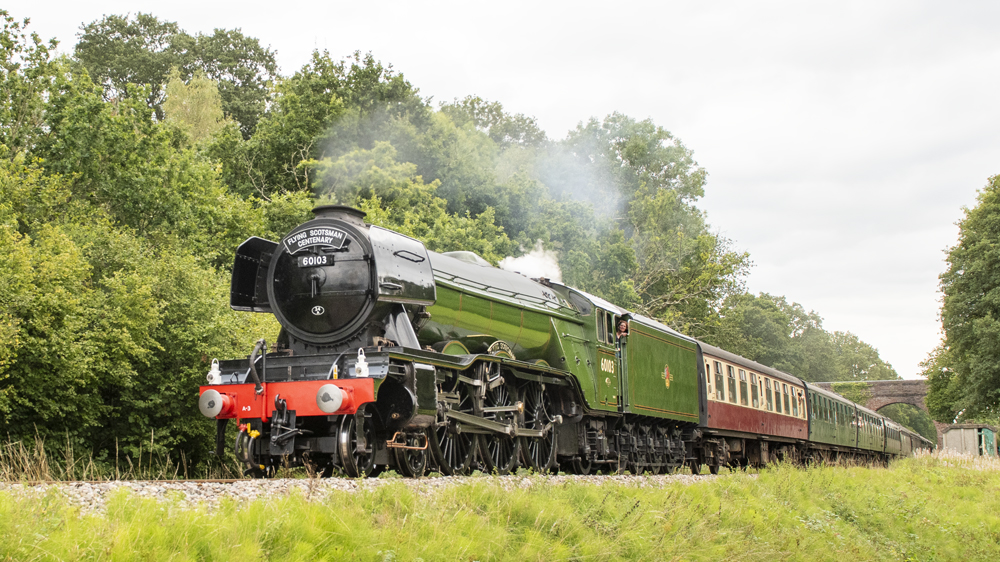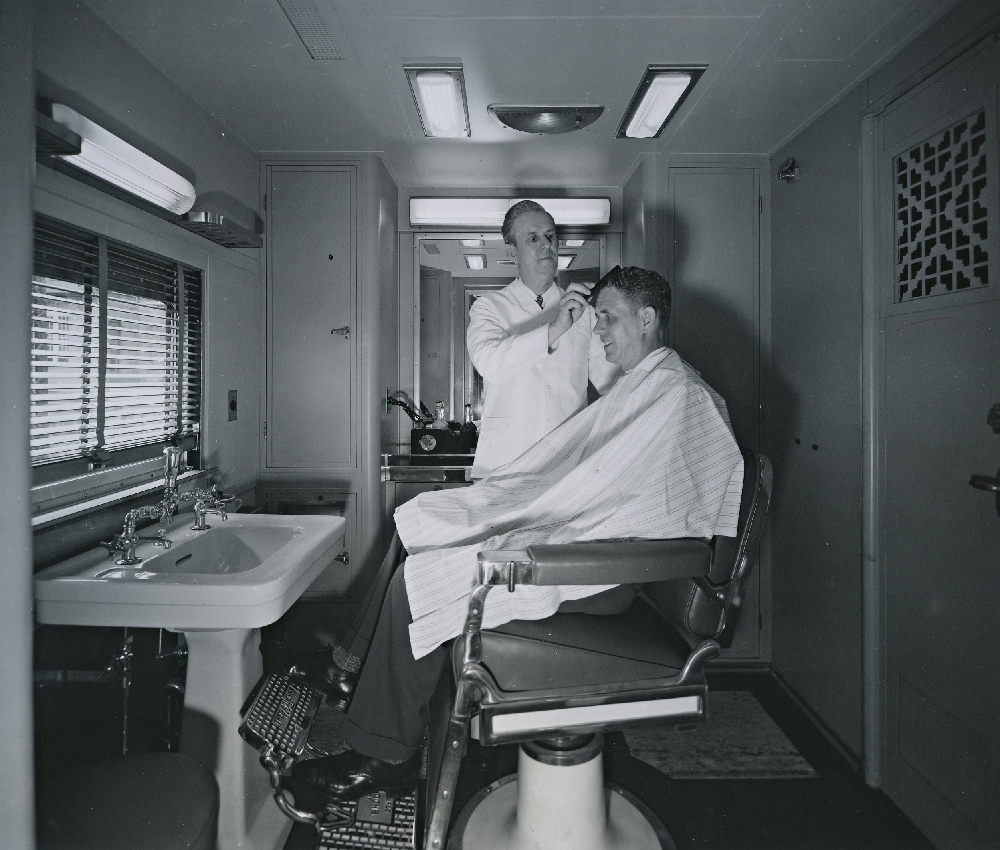Cass Scenic Railroad
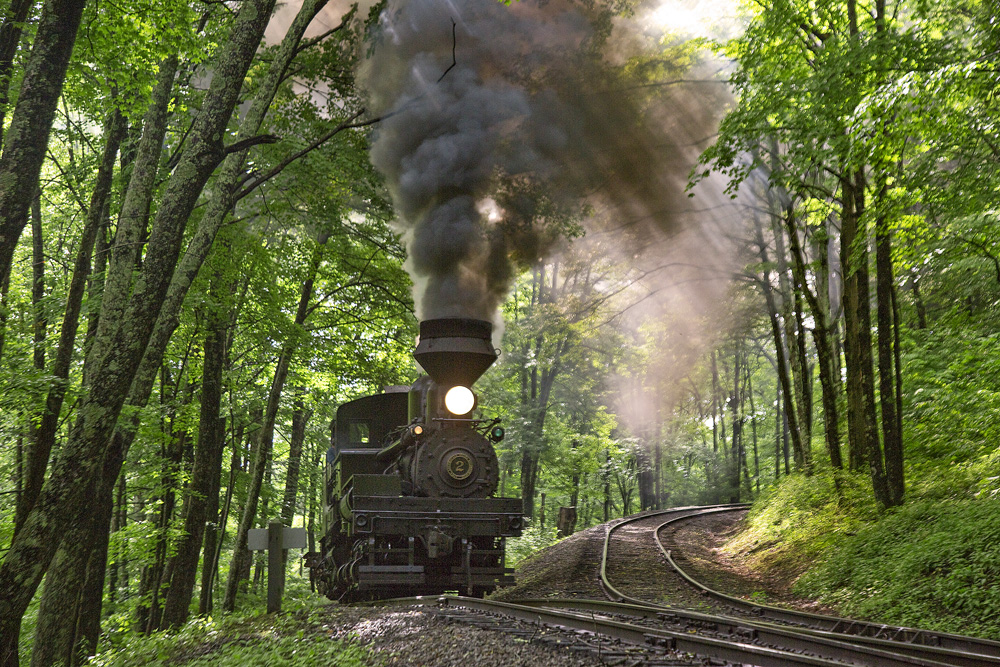
THIS IS A STORY ABOUT ONE SUMMER in the life of a fireman on the Cass Scenic Railroad in Cass, W.Va. I was hired in 1972 as a shop hand and extra fireman. I worked about six months in the shop and then was put on as regular fireman on the short run — a 4-mile trip up Cheat Mountain, with grades up to 10%, three times a day. The regular engineer was a man who liked to run fast and with the Johnson Bar full forward for maximum power. I had my work cut out for me to maintain water and steam in the boiler. The engine I drew was 80-ton Shay No. 4, which was a good steamer.
THE FIREMAN’S DAY
My day started long before the first tourist appeared. Each morning, I first checked the boiler water level, then blowing down the water glass to see if it was working properly. Next, I would open the firebox door and look for leaks or any kind of bulge in the boiler. Then I would put the screen on the smokestack to keep hot cinders from setting fire to the right-of-way.
Leveling out the fire and shaking the grates until the ashes fell in the ash pan was next, followed by going under the engine and raking out the ash pan.
By now steam pressure would be rising. Back in the cab I added a little more coal to the fire and checked both injectors to see if they were working. As I waited for steam pressure to rise, I would sweep the cab roof and running boards. Then, if there was time, I’d shine the bell and number plate.
With the steam up, it was time to make up our train and head for the depot. On my first run up the mountain I did everything my father, a lifelong railroad man, had taught me years before.
No. 4 was a good steamer, but the engineer showed me no mercy on my first day. I fought all the way for steam and water and made it without stalling.
I got better with each trip, learned the grade, and knew what the engineer was going to do before he did it. I was known as the fireman that did not make smoke and could lift No. 4’s safety valves at any time.
I played a trick on our conductor by being on my seat, looking out the window, when the train was in a long curve allowing him to view the fireman’s side. One day, in the shop, he said a fireman who worked back in log train days could fire an engine and stay seated half of the time. “Now,” he said, “Burdette can fire one of these engines and sit on his seat all of the time.”
What he didn’t know was I fired before the curve, making sure the stack was clear in time to be in my window watching the scenery when we reached that curve.
NO. 4 ON THE GROUND
Once, on the day’s first trip up the mountain, we came out of the first switchback and into Gum Curve, which is on a heavy grade. Suddenly No. 4 began to spin its wheels wildly and jumped the track.
We climbed down and discovered the line shaft had come apart just behind the cylinders. That rendered the rear two trucks useless, as they were receiving no power. The broken line shaft landed on the track and derailed the front truck.
We waited until the Bald Knob train came up. They took our passengers and returned to Cass. We put down the rerailers and, with the front trucks for power and the downhill pull of the cars, rerailed No. 4. We got her back to the shop on her own power.
TOUGH NO. 5
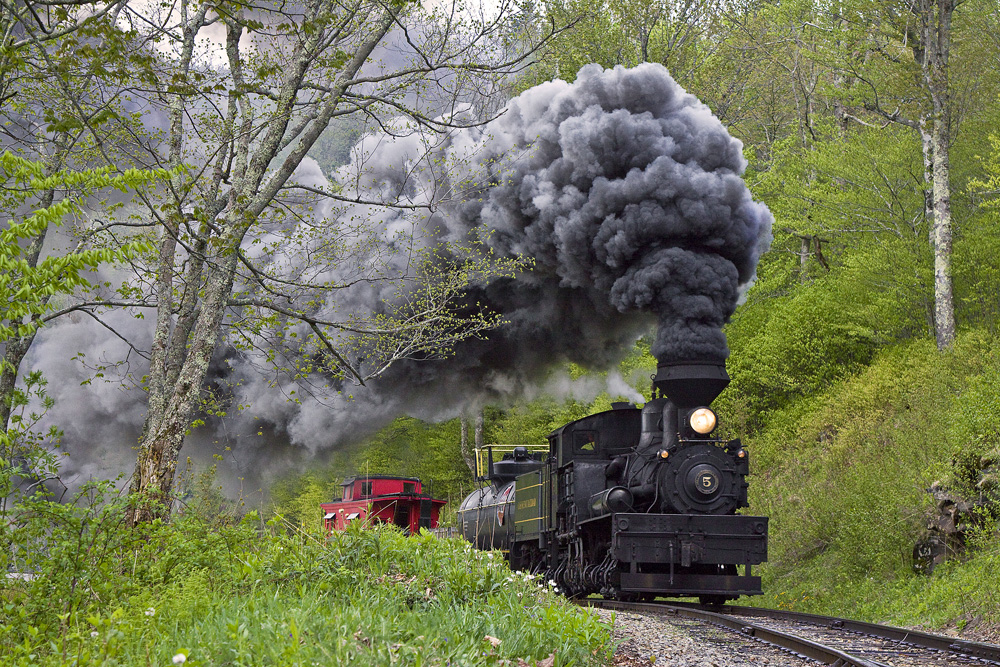
The next day I fired No. 5. She was known to be hard to steam — if the engineer abused her. I knew I was in trouble by the time we passed the shop. I watched the engineer open the throttle wider and my steam pressure go down 25 pounds. No. 5 is a 90-ton Shay with the safety valve set to pop at 200 pounds of pressure. I had 175 pounds of steam and the grade was getting steeper. Something had to be done quickly. I began to think of things my dad told me to watch when steam pressure dropped quickly. I got the fire hook down from the tender, turned it upside down, and began running it all over the firebox. It didn’t take long to discover two large holes in the front of the fire.
I shut off the injector, raked hot coals back on the bare grates, and put several shovels of coal in that area. The injector couldn’t be left off too long or I would have low water and low steam. I waited until the needle on the steam gauge started to move upward, and then put the gun (injector) back on. All the way to the first switchback I kept the injector off, thereby not losing any pressure from opening of the fire door.
Pulling into the first switchback, the engineer closed the throttle, and No. 5 lifted her safety valve. My water was on the mark.
Now came the real test. A Shay is harder to fire when it is backing up, and it’s about a mile to the next switchback. As we began moving backward, I waited until the smoke cleared from the stack, then turned my shovel upside down and stuck it in the fire door, turning it in different directions. This made the fire “lay down,” allowing me to see its condition. My fire was pool-table level.
After the first hard pull, the fire was white hot, and I began my firing routine again, never firing against the gun but jerking it on with one sweeping motion each time the last full shovel of coal went through the fire door. The steam pressure stayed right at 200 pounds. I would not allow the safety to pop, or for the steam to drop.
As we backed through what is known as Limestone Cut, I could not resist any longer. It’s a hard pull through this cut and most firemen, if they don’t watch carefully, will lose 15 to 20 pounds of steam. Today, as No. 5 got down on her knees, the pop valves lifted with a mighty roar. We backed on up to the second switchback with the pop valve just ready to release.
Next, I was facing a 11% grade and five curves into Whittaker Station. As we came forward out of the switchback, the engineer really opened the throttle wide. I shut off the gun and bailed coal into the firebox. The gun stayed off until we entered the first of the five curves and began ascending the 11% grade. The steep grade was getting the better of the engine. It began slowing down. The safety was about to pop off. I put the gun back on, keeping steam pressure at 200 pounds.
I got up on my seat, and watched the scenery go by. It is all up to the engineer now — my steam pressure and water were right on the mark. The engine got down to a crawl and you could feel the locomotive shudder as it strained against the load. Whittaker Station came into sight. It feels like my father and grandfather are riding with me. In a way they were, because my firing was just as they had taught me years before. In the days that followed, there was no trouble in keeping No. 5 hot.
TAKING ON NO. 6 — A HEISLER
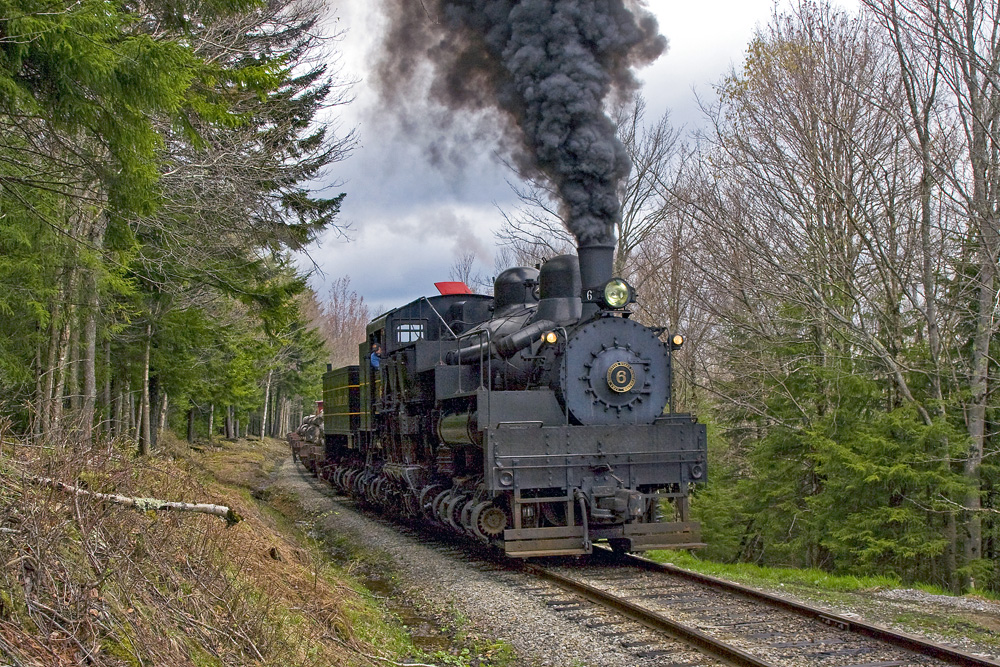
I fired No. 5 for about a month, then got the No. 4 back. About a week later, No. 4 had to go into the shop. This time I drew No. 6 — a 100-ton Heisler locomotive, which was known to be a tough engine to keep hot. No. 6 had a long firebox, and a fire door close to the cab floor. This combination forced you to bend way over when shoveling coal, making it exceedingly hard to reach the firebox front.
Additionally, No. 6 was easy to flood — put too much water in the boiler and it will end up in the cylinders.
As we went around the water tank on my first No. 6 trip, I promptly lost 25 pounds of steam. I knew I was in trouble because we were just starting up the mountain.
A mile up the mountain, at the first road crossing, steam was still down to 175 pounds and the grade was getting tougher. I fought for every foot of track. My water level was dropping as well as my steam pressure and the engineer would not ease up on the throttle and give No. 6 and I a chance to catch up.
We limped to the first switchback with 150 pounds of steam and low water. Here I thought the engineer would let me catch up on water and steam, but instead he reversed the locomotive and began backing up the steep grade into Gum Field.
The water was too low for me to knock off the gun. We made it to Gum Curve — and stalled. Knowing the engineer would try to make up for lost time, I made no attempt to raise steam until enough water was in the boiler. Once we started to move, having plenty of water would allow me to leave the gun off a bit. This way we might be able to limp into the next switchback, while gaining a little more steam and maintaining water. We sat there stalled for what seemed like an hour to a red-faced fireman, but was only a few minutes.
The engineer waited until steam pressure reached 200 pounds and then pulled out. We made it to the second switchback with enough water but low steam pressure. Now it was a different story. The gun could stay off. As we came out of the switchback going forward, I could see No. 6 was getting hot.
As we went into the S curve at the base of the grade, No. 6’s safety was trying to pop but I wasn’t going to allow it and put the injector on. Still, she tried to pop. I began fanning the fire door — opening and closing it, letting cold air enter the firebox.
I kept the safety from lifting until we got up over that section of track then, just for the heck of it, let her pop!
I fired No. 6 many times after this and while she remained a cranky old lady, she never stalled on me again.
OIL-BURNING NO. 3
The next engine I fired at Cass was No. 3, an oil-burning, 100-ton Shay. No. 3 was a good steamer and rode easy. She had a large all-weather cab, and all the firing controls were easy to reach from the fireman’s seat. The water glass and steam gauge were also easy for the fireman to see. I fired the No. 3 for a long time before returning to my regular engine, No. 4.
ONE FAST WEEKEND
One day as I was going to my car after work, the boss stopped me and said I was to report the next day as fireman on the lead engine for the “long run” — the train that goes to the top of Cheat Mountain with grades up to 12%. He told me I would be on No. 2, a 100-ton oil-fired Shay. My engineer would be a retired man coming back to work for just one weekend.
The next morning found the engineer bragging that he was going to get to the top of Cheat Mountain 30 minutes ahead of the regular arrival time.
No. 5 was serving as the helper engine today. I got No. 2 ready, and we were at the depot on time. As departure time grew near, I wondered what the trip would be like.
At five minutes before departure time, No. 5 coupled on to our tender. Up in No. 2’s cab I made some last-minute adjustments. My water was right where I wanted it; the steam gauge read 199 pounds.
The conductor gave us the highball signal as he came out of the depot. I turned and relayed it to the engineer, who reached up pulling the whistle cord twice, released the brakes, and opened the throttle. We left the depot right on time.
He gave her time until we reached the locomotive shop and then the throttle really came out! No. 2 shot smoke and steam sky high, and the drivers began to spin wildly. He didn’t let up on the throttle, he just put more sand on the rails. The noise in the cab was like I had never heard before. I thought surely No. 2 would tear apart in the middle. Turning the oil valve almost closed, I got down on the gangway, putting sand through the firebox door to clear the soot out of the flues. I glanced up at the steam gauge and had lost 25 pounds in the time it took to do this. I grabbed the oil valve, turning it wide open, and watched for what seemed like a long time before the steam pressure started back up. By the time we passed the first road crossing I was back up to 185 pounds on the pressure gauge.
From here to the first switchback, it was a battle to maintain water and steam. We pulled into the switchback with 175 pounds of steam, but the water was good. As we backed between the first and second switchbacks, I was only able to hold the 175 pounds of steam.
If I could limp into Whittaker Station — where we would stop for about 30 minutes — maybe I could catch up. Well, he hogged her into Whittaker Station ahead of time. As we sat there, I went back to the pusher engine to see how they were doing and talk about what a ride we were taking. The engineer of No. 5 said, “Hell, man, you are taking the whole train. It’s all I can do just to keep up.”
When the trip resumed, I was back at it, maintaining my water level but unable to get above 185 pounds of steam. Although we arrived at the top 30 minutes early, as my engineer had boasted, I knew he would try to beat that the next day.
Lying in bed that night, I tried to figure out why I couldn’t get No. 2 above 185 pounds of pressure. I remembered adjusting the controls didn’t seem to make a difference but when I sanded the flues it helped steam pressure for a while. I decided, there in bed, to do more sanding of the flues and leave the controls set in a good position.
The next morning, I made sure the sandbox in No. 2’s cab was full. We went to the depot on time and when we got there, two railroad officials from Charleston, W.Va., climbed up in the cab and told the engineer what a fine job he had done the day before. I knew today was going to be a fast ride!
I went back to the No. 5 pusher engine and relayed what had been said, warning them to expect an even faster trip. I had No. 2 ready when No. 5 coupled up. I glanced back at the pusher fireman, who wiped his face as if already sweating.
We left on time and, again, as we cleared the shop area, the No. 2’s throttle was pulled wide open. This time I was ready. I left the oil valve alone but put about 5 gallons of sand through the fire door. Much to my surprise, the hand on the steam gauge rose steadily towards the 200-pound mark, which was where the pop valve would lift. I could now cut back on the oil valve and control the pop valve.
For the rest of the trip, whenever steam pressure would lag, I knew it was time to sand the flues.
Our two trips to Bald Knob on Cheat Mountain that weekend were the fastest ever to the summit — a record that still stands today. I learned a Shay will take a good amount of punishment and keep on going.
HOMECOMING
I’m no longer with the railroad but I return each summer and fire at least one trip up the mountain. On some weekends I have fired the mighty No. 6 Shay, acquired from the Baltimore & Ohio Railroad Museum following my departure from Cass. It is the last Shay built and weighs in at a whooping 162 tons. No. 6 is a good steamer and rides like a rocking chair.
I have many of good memories of my railroad days and will never forget the smell of valve oil mingled with steam.
My favorite engine to fire? That’s easy: No. 5. She’s the oldest engine at Cass, arriving new in 1905 and has spent her entire life on Cheat Mountain. She has seen a lot of engineers and firemen come and go. My dad engineered No. 5 for many years and was the first engineer to put her on top of Bald Knob.
No. 5 is like one of the family to me. I try to return each summer to shovel a little coal into her firebox and listen to her soft exhaust as she works her way up Cheat Mountain on rails that seem to reach the sky.








